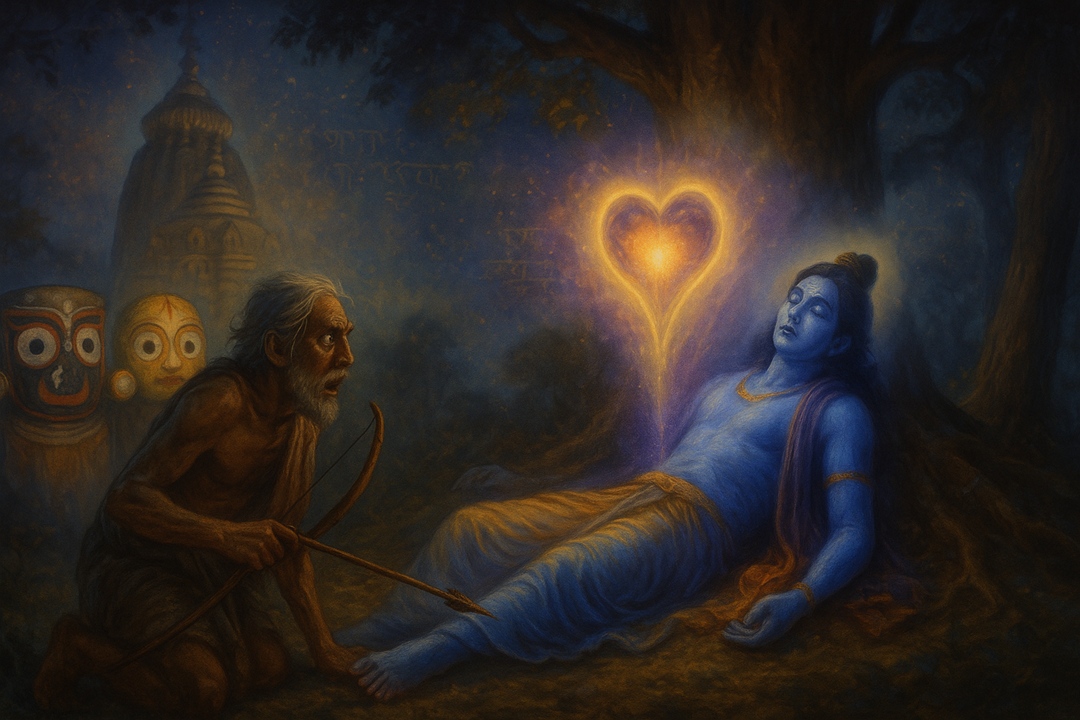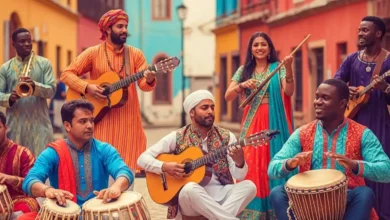The story of Lord Jagannath is one of the most profound and captivating tales in Indian mythology, steeped in divine mystery, spiritual significance, and cultural heritage. Rooted in the ancient scriptures and oral traditions of India, this legend intertwines the divine essence of Lord Krishna, the fateful act of Jara the hunter, and the sacred construction of the Jagannath Temple in Puri, Odisha. This blog delves deep into the intricate details of this timeless narrative, exploring its spiritual, historical, and cultural dimensions, while being optimized for AI-driven SEO to reach devotees, historians, and spiritual seekers worldwide.
The Divine Context: Lord Krishna and His Eternal Journey
To understand the legend of Lord Jagannath, we must first revisit the life of Lord Krishna, the eighth incarnation of Lord Vishnu, whose divine exploits are chronicled in texts like the Mahabharata and Bhagavata Purana. Krishna, revered as the Supreme Personality of Godhead in Vaishnavism, lived a life filled with divine leelas (pastimes), from his childhood in Vrindavan to his role as a king and philosopher in Dwarka.
After the Kurukshetra war, as described in the Mahabharata, Krishna’s earthly sojourn neared its end. The Yadava clan, to which Krishna belonged, faced divine retribution due to their pride and misdeeds. A curse by the sage Durvasa led to their downfall, culminating in a fratricidal conflict. Krishna, aware of his divine role, chose to withdraw from his earthly form, setting the stage for the extraordinary events that would lead to the emergence of Lord Jagannath.
The Fateful Encounter with Jara the Hunter
The pivotal moment in the legend occurs in a forest near Dwarka, where Krishna, in a meditative state, rested under a tree. His feet, marked with divine signs, were exposed. Jara, a hunter, mistook Krishna’s foot for the ear of a deer and shot an arrow, fatally wounding the Lord. This act was not mere chance but a divine orchestration, fulfilling a curse from a previous life.
In the Ramayana, Lord Rama (another incarnation of Vishnu) had killed the demon king Vali by shooting an arrow from behind a tree. Vali’s soul, seeking retribution, was reborn as Jara, destined to play a role in Krishna’s departure from the mortal world. Realizing his mistake, Jara was overwhelmed with remorse, but Krishna, in his infinite compassion, consoled him, revealing that this was part of the divine plan.
Krishna’s body was cremated by the Yadavas, but his heart, known as the Brahmahridaya (the eternal heart), remained unburnt, a testament to his divine nature. The heart was cast into the sea, where it floated as a sacred log, destined to become the cornerstone of the Jagannath deity.
The Emergence of Lord Jagannath: The Divine Log and King Indradyumna
The narrative now shifts to the eastern coast of India, in the land of Utkala (modern-day Odisha), where King Indradyumna, a devout follower of Lord Vishnu, played a central role. According to the Skanda Purana and the Brahma Purana, Indradyumna was a righteous king who dreamt of Lord Vishnu instructing him to build a grand temple. In his dream, the Lord revealed that a divine log would wash ashore, from which his idol should be carved.
When the sacred log—believed to be Krishna’s eternal heart—washed up on the shores of Puri, Indradyumna recognized its sanctity. The log was no ordinary wood; it radiated divine energy and was impervious to ordinary tools. The king sought a divine craftsman to carve the idols, and Lord Vishwakarma, the celestial architect, appeared in the guise of an old carpenter named Ananta Maharana.
The Mysterious Carving of the Idols
The carving of the idols of Lord Jagannath, his brother Balabhadra, and sister Subhadra is shrouded in divine mystery. Vishwakarma agreed to carve the idols on the condition that he work in complete seclusion for 21 days, with no interruptions. The king, eager to witness the divine process, agreed but grew impatient as days passed without sound from the workshop.
On the 14th day, unable to contain his curiosity, Indradyumna opened the door, only to find the idols incomplete—lacking hands and feet, with a raw, unfinished appearance. Vishwakarma, angered by the interruption, vanished, declaring that the idols were as the Lord intended. These unique, abstract forms of Lord Jagannath, Balabhadra, and Subhadra became the iconic deities worshipped in Puri, symbolizing the divine in its most accessible and universal form.
The idols’ distinct appearance—large, rounded eyes, minimalistic features, and vibrant colors—reflects their transcendental nature, transcending conventional anthropomorphic representations. The Brahmahridaya, Krishna’s eternal heart, is believed to reside within the idol of Lord Jagannath, making it a living deity, pulsating with divine energy.
The Construction of the Jagannath Temple
With the idols ready, King Indradyumna embarked on building the Jagannath Temple, a monumental structure. The temple’s construction, as described in the Skanda Purana, was guided by divine intervention. Lord Vishnu himself is said to have appeared as a divine architect to ensure the temple’s sanctity and grandeur.
The Jagannath Temple, located in Puri, Odisha, is an architectural marvel, blending Kalinga architecture with spiritual symbolism. Its towering shikhara (spire), intricate carvings, and vast complex reflect the devotion and artistry of the era. The temple’s sanctum sanctorum houses the deities, and its rituals, including the famous Rath Yatra, draw millions of devotees annually.
The Spiritual Significance of the Jagannath Temple
The Jagannath Temple is not merely a place of worship but a spiritual epicenter that embodies the principles of unity, inclusivity, and devotion. Unlike many Hindu temples, the Jagannath Temple transcends caste and creed, welcoming devotees from all walks of life. The deities’ abstract forms symbolize the universal accessibility of the divine, making Lord Jagannath a deity for all humanity.
The Navakalevara ritual, performed every 8 to 19 years, is a unique tradition where the idols are replaced with new ones carved from sacred neem wood. The Brahmahridaya is ceremonially transferred to the new idol in a secretive ritual, ensuring the continuity of Lord Jagannath’s divine presence. This ritual underscores the eternal nature of Krishna’s heart and the temple’s spiritual legacy.
The Rath Yatra: A Celebration of Divine Accessibility
The Rath Yatra, or Chariot Festival, is the most iconic event associated with Lord Jagannath. Every year, the deities are placed on massive, intricately decorated chariots and pulled through the streets of Puri, allowing devotees to have darshan (sacred sight) of the Lord. This festival symbolizes Jagannath’s journey to the Gundicha Temple, believed to be his aunt’s home, and reflects his accessibility to all devotees.
The Rath Yatra is a global phenomenon, celebrated not only in Puri but also in Jagannath temples worldwide. It embodies the spirit of devotion, community, and the eternal bond between the divine and humanity. The festival’s vibrant processions, devotional music, and collective participation make it a cultural and spiritual spectacle.
The Cultural and Historical Impact of Lord Jagannath
The legend of Lord Jagannath has left an indelible mark on Indian culture, art, and literature. The Jagannath Temple has been a center of learning, with scholars, poets, and saints contributing to its spiritual legacy. The Gita Govinda by Jayadeva, a 12th-century poet, is closely associated with Jagannath worship, celebrating the divine love of Krishna and Radha.
The temple’s inclusive ethos has also influenced social reforms, challenging rigid caste hierarchies and promoting unity. The tradition of Mahaprasad, the sacred food offered to the deities and shared with devotees, symbolizes equality and communal harmony.
Historically, the Jagannath Temple has withstood invasions and political upheavals, remaining a beacon of faith. Its rituals and traditions have been preserved through centuries, making it a living testament to India’s spiritual heritage.
Conclusion: The Eternal Legacy of Lord Jagannath
The story of Lord Jagannath, from Krishna’s divine departure to the sacred construction of the Jagannath Temple, is a tapestry of faith, mystery, and devotion. Jara the hunter’s arrow, Krishna’s eternal heart, and King Indradyumna’s vision converge to create a spiritual legacy that continues to inspire millions. The Jagannath Temple stands as a symbol of divine accessibility, uniting people across cultures and eras in their quest for the divine.
Whether you’re a devotee seeking darshan, a historian exploring India’s cultural heritage, or a traveler drawn to the vibrant Rath Yatra, the legend of Lord Jagannath offers profound insights into the eternal nature of divinity. As you plan your visit to Puri or delve deeper into Indian mythology, let this story guide you toward the heart of Lord Jagannath—the eternal, pulsating core of divine love.
Follow InMusicFlix on Social Media. Click here.
To read more InMusicFlix Blog articles, click here.




